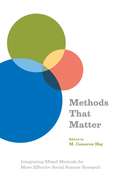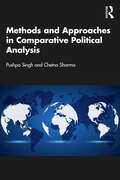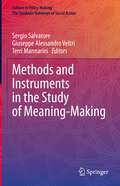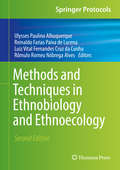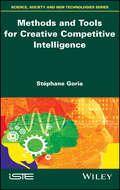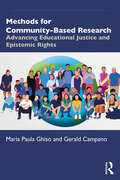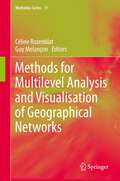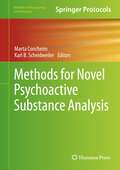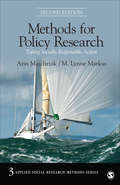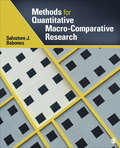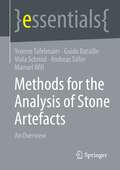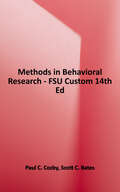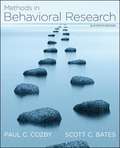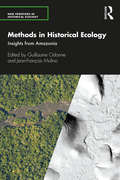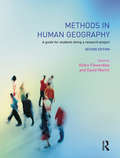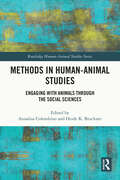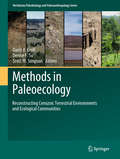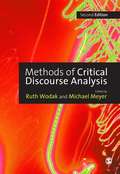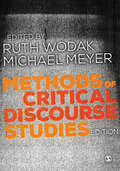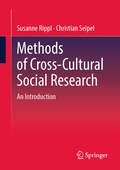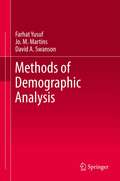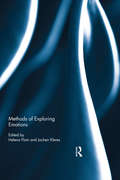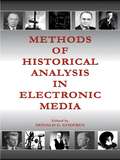- Table View
- List View
Methods That Matter: Integrating Mixed Methods for More Effective Social Science Research
by M. Cameron HayTo do research that really makes a difference--the authors of this book argue--social scientists need questions and methods that reflect the complexity of the world. Bringing together a consortium of voices across a variety of fields, Methods that Matter offers compelling and successful examples of mixed methods research that do just that. In case after case, the researchers here break out of the traditional methodological silos that have long separated social science disciplines in order to better describe the intricacies of our personal and social worlds. Historically, the largest division between social science methods has been that between quantitative and qualitative measures. For people trained in psychology or sociology, the bias has been toward the former, using surveys and experiments that yield readily comparable numerical results. For people trained in anthropology, it has been toward the latter, using ethnographic observations and interviews that offer richer nuances of meaning but are difficult to compare across societies. Discussing their own endeavors to combine the quantitative with the qualitative, the authors invite readers into a conversation about the best designs and practices of mixed methodologies to stimulate creative ideas and find new pathways of insight. The result is an engaging exploration of a promising new approach to the social sciences.
Methods and Approaches in Comparative Political Analysis
by Pushpa Singh Chetna SharmaThis book focuses on the methods and approaches in comparative politics while tracing the evolution of the discipline. Exploring its historical legacy through a comparative perspective, it uses research methods and methodologies to critically analyse the approaches used in the book.This unique volume provides an exclusive reading on the dimension of gender in comparative politics. It also investigates the foundational approaches and insights from the perspective of postcolonial societies and diverse regions of the world.Lucidly written to serve a diversity of readership, this book is an invaluable resource for students, researchers, and teachers from the departments of political science, public administration, history, and journalism. Owing to its detailed, diverse, and rich discussions on the different aspects of these themes, it will be equally useful to researchers in the field of gender studies and comparative politics.
Methods and Instruments in the Study of Meaning-Making (Culture in Policy Making: The Symbolic Universes of Social Action)
by Sergio Salvatore Terri Mannarini Giuseppe Alessandro VeltriThis volume develops a theoretical framework for the modelling of meaning-making and cultural processes as crucial to the scientific study of contemporary complex societies. It focuses on the methodological and empirical aspects of the analysis of culture and its dynamics that could be applied to policymaking and to the understanding of social phenomena. It covers culture-based segmentation, ad hoc survey instruments like the VOC and PROSERV questionnaires, discourse flow analysis, the Homogenization of Classification Functions Measurement, and others. It also presents a detailed discussion of the methodology of cultural analysis in contexts of health and education. The volume showcases a top-down approach by including quantitative methods and/or automatized or semi-automatized procedures, and at the same time supports a hermeneutic, bottom-up, abductive approach, focused on the situated dynamics of meaning-making. It provides insights from cultural studies, social statistics, social policy, and research methodology in the social sciences. This is a useful resource for academics involved in studying cultural dynamics and for policy-oriented researchers and decision-makers who are interested in cultural dimensions of the design, implementation and reception of public policies.
Methods and Techniques in Ethnobiology and Ethnoecology (Springer Protocols Handbooks)
by Ulysses Paulino Albuquerque Rômulo Romeu Alves Reinaldo Farias de Lucena Luiz Vital Cruz da CunhaEthnobiology and ethnoecology have become very popular in recent years. Particularly in the last 20 years, many manuals of methods have published the most classical approaches to the subject. There have been, however, many advances in research as a result of interaction with different disciplines, but also due to more recent results, new original and interesting questions.This handbook provides the current state of the art methods and techniques in ethnobiology and ethnoecology, and related fields. This new volume, besides bringing new and original aspects of what is found in the literature, fills some of the gaps in volume one by including the most systematic and extensive treatment of methods and techniques in qualitative research. Along with the various methods covered in the individual chapters, the handbook also includes an extensive bibliography that details the current literature in the field.
Methods and Tools for Creative Competitive Intelligence
by Stéphane Goria"Creative competitive intelligence" is an information-seeking and monitoring activity of an information environment for the purpose of creativity and innovation. It involves the process leading up to the development of an informational supply adapted to the inspiration of creative or innovative personnel. This dynamic aims for the recognition of novelties (ideas, products, technologies, etc.), the identification of new players in the world of creation and innovation, and the identification of forgotten or neglected developmental paths. This book is aimed at readers who already have some experience of innovation and who are now looking for new ways to discover new products under development, anticipate the design of future products, identify unexplored tracks of inventions, develop and analyze innovation strategies, or recognize the emergence of budding artists.
Methods for Community-Based Research: Advancing Educational Justice and Epistemic Rights
by María Paula Ghiso Gerald CampanoMethods for Community-Based Research describes how Community-Based Research (CBR) is particularly suited to understand and take action on issues of educational justice.The book shifts assumptions about who is considered a researcher, drawing attention to issues of power and the ethics of collaborations, and foregrounding how those who have often been positioned as the objects of educational interventions can—and have the rights to—play an active role in creating educational arrangements more conducive to their own flourishing.The authors draw on a decade-long partnership across the boundaries of race, language, immigration status, and institutional affiliation to provide examples that illustrate the complexities and possibilities of this work. They distill principles, practices, and ongoing inquiries for researchers to consider across all aspects of the research process.The book supports researchers in creating the conditions for collaborative inquiry into issues of educational (in)justice that are salient to community partners. It will be of interest to advanced undergraduate, graduate students and scholars in education, and other disciplines that utilize a CBR method such as healthcare research and anthropology, as well as scholars interested in qualitative methods and issues of social justice in research.
Methods for Multilevel Analysis and Visualisation of Geographical Networks
by Céline Rozenblat Guy MelanconThis leading-edge study focuses on the latest techniques in analysing and representing the complex, multi-layered data now available to geographers studying urban zones and their populations. The volume tracks the successful results of the SPANGEO Project, which was set up in 2005 to standardize, and share, the syncretic, multinational mapping techniques already developed by geographers and computer scientists. SPANGEO sought new and responsive ways of visualising urban geographical and social data that reflected the fine-grained detail of the inputs. It allowed for visual representation of the large and complex networks and flows which are such an integral feature of the dynamism of urban geography. SPANGEO developed through the 'visual analytics loop' in which geographers collaborated with computer scientists by feeding data into the design of visualisations that in turn spawned the urge to incorporate more varied data into the visualisation. This volume covers all the relevant aspects, from conceptual principles to the tools of network analysis and the actual results flowing from their deployment. Detailed case studies set out in this volume include spatial multi-level analyses of flows in airports and sea ports, as well as the fascinating scientific networks in European cities. The volume shows how the primary concern of geography--the interaction of society with physical space--has been revivified by the complexities of new cartographical and statistical methodologies, which allow for highly detailed mapping and far more powerful computer analysis of spatial relationships.
Methods for Novel Psychoactive Substance Analysis (Methods in Pharmacology and Toxicology)
by Marta Concheiro Karl B. ScheidweilerThis collection provides detailed information on current advances in analytical methods and strategies employed for monitoring and discovering a wide range of novel psychoactive substances (NPS) in clinical and forensic laboratories. The main classes of NPS in terms of prevalence include synthetic cannabinoids, synthetic cathinones, synthetic opioids, and designer or synthetic benzodiazepines, and this book explores selecting the appropriate sample matrix and analytical testing approaches for laboratories faced with NPS drug testing, such as in blood, urine, saliva, and hair. Written for the Methods in Pharmacology and Toxicology series, chapters in this volume feature the kind of detailed implementation advice from the experts that leads to successful results in the lab. Authoritative and practical, Methods for Novel Psychoactive Substance Analysis serves as an ideal guide for forensic and clinical toxicologists, pharmacologists and chemists in academic and research settings, as well as for private laboratories seeking to increase our ability to test for these substances. @font-face {font-family:"Cambria Math"; panose-1:2 4 5 3 5 4 6 3 2 4; mso-font-charset:0; mso-generic-font-family:roman; mso-font-pitch:variable; mso-font-signature:-536869121 1107305727 33554432 0 415 0;}@font-face {font-family:Calibri; panose-1:2 15 5 2 2 2 4 3 2 4; mso-font-charset:0; mso-generic-font-family:swiss; mso-font-pitch:variable; mso-font-signature:-469750017 -1073732485 9 0 511 0;}p.MsoNormal, li.MsoNormal, div.MsoNormal {mso-style-unhide:no; mso-style-qformat:yes; mso-style-parent:""; margin:0cm; mso-pagination:widow-orphan; font-size:12.0pt; mso-bidi-font-size:11.0pt; font-family:"Times New Roman",serif; mso-fareast-font-family:Calibri; mso-fareast-theme-font:minor-latin; mso-bidi-font-family:"Times New Roman"; mso-bidi-theme-font:minor-bidi; mso-ansi-language:EN-US; mso-fareast-language:EN-US;}.MsoChpDefault {mso-style-type:export-only; mso-default-props:yes; mso-bidi-font-size:11.0pt; mso-fareast-font-family:Calibri; mso-fareast-theme-font:minor-latin; mso-bidi-font-family:"Times New Roman"; mso-bidi-theme-font:minor-bidi; mso-ansi-language:EN-US; mso-fareast-language:EN-US;}div.WordSection1 {page:WordSection1;}
Methods for Policy Research: Taking Socially Responsible Action (Applied Social Research Methods)
by Ann Majchrzak M. Lynne MarkusThis book about responsible and evidence-based decision making is written for those interested in improving the decisions that affect people’s lives. It describes how to define policy research questions so that evidence can be applied to them, how to find and synthesize existing evidence, how to generate new evidence if needed, how to make acceptable recommendations that can solve policy problems without negative side effects, and how to describe evidence and recommendations in a manner that changes minds. Policies are not just the decisions made by a country’s rulers or elected officials; policies are also set by corporate executives, managers of department stores, and project leaders in non-profit organizations pursuing environmental protection. The authors’ suggestion are based on the fundamental belief that evidence-based decision making is superior to decisions based purely on opinion, intuition, and emotion. Because much has happened since 1984 when the first edition was published, this is a substantially different book with a new co-author, new and updated examples, new chapters, and new frameworks for understanding.
Methods for Quantitative Macro-Comparative Research
by Salvatore J. BabonesWill a one-child policy increase economic growth? Does globalization contribute to global warming? Are unequal societies less healthy than more egalitarian societies? It is questions like these that social scientists turn to quantitative macro-comparative research (QMCR) to answer. Although many social scientists understand statistics conceptually, they struggle with the mathematical skills required to conduct QMCR. This non-mathematical book is intended to bridge that gap, interpreting the advanced statistics used in QMCR in terms of verbal descriptions that any college graduate with a basic background in statistics can follow. It addresses both the philosophical foundations and day-to-day practice of QMCR in an effort to improve research outcomes and ensure policy relevance. A comprehensive guide to QMCR, the book presents an overview of the questions that can be answered using QMCR, details the steps of the research process, and concludes with important guidelines and best practices for conducting QMCR. The book assumes that the reader has a sound grasp of the fundamentals of linear regression modeling, but no advanced mathematical knowledge is required in order for researchers and students to read, understand, and enjoy the book. A conversational discussion style supplemented by 75 tables and figures makes the book′s methodological arguments accessible to both students and professionals. Extensive citations refer readers back to primary discussions in the literature, and a comprehensive index provides easy access to coverage of specific techniques.
Methods for the Analysis of Stone Artefacts: An Overview (essentials)
by Yvonne Tafelmaier Guido Bataille Viola Schmid Andreas Taller Manuel WillThis essential gives an overview of current methods of analysis of stone artefacts ranging from attribute analysis of entire inventories to microscopic analyses of traces of use of individual artefacts. The presented approaches show the range of analysis of prehistoric stone artefacts in the German-speaking area. Simple examples of application illustrate the possibilities and limitations of each method. The content and structure of the essentials is identical to teaching units for learning methods of stone artefact analysis at the University of Tübingen in the Department of Early Prehistory.
Methods in Behavioral Research
by Paul C. Cozby Scott C. BatesThis book guides students toward success by helping them study smarter and more efficiently. Supported by SmartBook®, McGraw-Hill Education's adaptive and personalized reading experience, Cozby and Bates provide helpful pedagogy, rich examples, and a clear voice in their approach to methodological decision making.
Methods in Behavioral Research (Eleventh Edition)
by Paul C. Cozby Scott C. BatesMethods in Behavioral Research has achieved its market-leading position with its concise and strategic approach to methodological decision making. Combining helpful pedagogy and rich examples, Cozby's eleventh edition again incorporates learning objectives, illustrative graphics, and activities to increase student involvement. Highlights of the new edition include a broader introduction of different research techniques in Chapter 4, extensive revision of the “validity of measurements̶ section, and updated structural equations models.
Methods in Behavioral Research (Thirteenth Edition)
by Bates CozbyMethods in Behavioral Research continues to guide students toward success by helping them study smarter and more efficiently. In tandem with SmartBook, McGraw-Hill Education’s adaptive and personalized reading experience, Cozby and Bates provide helpful pedagogy, rich examples, and a clear voice in their approach to methodological decision-making.
Methods in Historical Ecology: Insights from Amazonia (New Frontiers in Historical Ecology)
by Guillaume Odonne; Jean-François MolinoThis book presents some of the most recent tools, methods and concepts in historical ecology. It introduces students and researchers to state-of-the-art techniques and showcases a wide array of methods dedicated to understanding the history of tropical landscapes. The chapters cover the detection and characterisation of archaeological features, living organisms as witnesses of past human activities, ethnoecological knowledge of ancient anthropogenic landscapes and societal impacts of historical ecology. Whilst mainly based on Amazonian experiences, the contributions aim to strengthen synergies between disciplines and to propose solutions that can be applied elsewhere in the field.
Methods in Human Geography: A guide for students doing a research project
by Robin Flowerdew David M. MartinFirst published in 2004. Routledge is an imprint of Taylor & Francis, an informa company.
Methods in Human-Animal Studies: Engaging With Animals Through the Social Sciences (Routledge Human-Animal Studies Series)
by Annalisa Colombino Heide K. BrucknerThis timely book provides a methodological guide for how to conduct and theorise research in human-animal studies. In response to critiques of the anthropomorphic slant to human-animal research and the increasing political relevance of animals in contemporary environmental debates, this book emphasises methods which bring to light the animal side of multispecies encounters. Drawing from the interdisciplinary strength of human-animal studies, this book contains contributions from practitioners and scholars working in sociology, anthropology, ethology and geography. Each chapter uses a case-study approach to present a theoretical framework and empirical application of cutting-edge methods in human-animal studies, from creative writing in multispecies ethnographies to visual methods like videography and body mapping. Organized in three parts – theorizing; collaborating; visualizing – the book equips readers with methodological tools to conduct human-animal studies research attentive to animal lives. Furthermore, chapters reflect on the opportunities, limitations and ethical considerations of research that seeks to understand our more-than-human worlds. The book is aimed towards undergraduate and graduate students in human-animal studies and scholars investigating human-animal relations. It will also be of interest to practitioners and policy-makers who engage with conservation, wildlife management or the human-animal interface of urban and regional planning.
Methods in Paleoecology: Reconstructing Cenozoic Terrestrial Environments and Ecological Communities (Vertebrate Paleobiology and Paleoanthropology)
by Darin A. Croft Denise F. Su Scott W. SimpsonThis volume focuses on the reconstruction of past ecosystems and provides a comprehensive review of current techniques and their application in exemplar studies. The 18 chapters address a wide variety of topics that span vertebrate paleobiology and paleoecology (body mass, postcranial functional morphology, evolutionary dental morphology, microwear and mesowear, ecomorphology, mammal community structure analysis), contextual paleoenvironmental studies (paleosols and sedimentology, ichnofossils, pollen, phytoliths, plant macrofossils), and special techniques (bone microstructure, biomineral isotopes, inorganic isotopes, 3-D morphometrics, and ecometric modeling). A final chapter discusses how to integrate results of these studies with taphonomic data in order to more accurately characterize an ancient ecosystem. Current investigators, advanced undergraduates, and graduate students interested in the field of paleoecology will find this book immensely useful. The length and structure of the volume also makes it suitable for teaching a college-level course on reconstructing Cenozoic ecosystems.
Methods of Critical Discourse Analysis
by Michael Meyer Ruth WodakA new edition of this book is available This book is designed as an introduction to Critical Discourse Analysis (CDA) and gives an overview of the various theories and methods associated with this sociolinguistic approach. It also introduces the reader to the leading figures in CDA and the methods to which they are most closely related. The text aims to provide a comprehensive description of the individual methods, an understanding of the theories to which methods refer and a comparative treatment of each of these methods so that students may be able to determine which is the most appropriate to select for their particular research question. Given the balance between theory and application, plus the intended audience - no previous knowledge of CDA is assumed - Methods of Critical Discourse Analysis should be useful reading for both students and researchers in the fields of linguistics, sociology, social psychology and the social sciences in general.
Methods of Critical Discourse Studies (Introducing Qualitative Methods)
by Michael Meyer Ruth WodakThis is a sophisticated and nuanced introduction to critical discourse analysis (CDA) that covers a range of topics in an accessible, engaging style. With international examples and an interdisciplinary approach, readers gain a rich understanding of the many angles into critical discourse analysis, the fundamentals of how analysis works and examples from written texts, online data and images. This new edition: expands coverage of multimodality adds two new chapters on social media and analysis of online data supports learning with a guided introduction to each chapter includes a new and extended glossary Clearly written, practical and rigorous in its approach, this book is the ideal companion when embarking on research that focuses on discourse and meaning-making. Available with Perusall—an eBook that makes it easier to prepare for class Perusall is an award-winning eBook platform featuring social annotation tools that allow students and instructors to collaboratively mark up and discuss their SAGE textbook. Backed by research and supported by technological innovations developed at Harvard University, this process of learning through collaborative annotation keeps your students engaged and makes teaching easier and more effective. Learn more.
Methods of Critical Discourse Studies (Introducing Qualitative Methods)
by Michael Meyer Ruth WodakThis is a sophisticated and nuanced introduction to critical discourse analysis (CDA) that covers a range of topics in an accessible, engaging style. With international examples and an interdisciplinary approach, readers gain a rich understanding of the many angles into critical discourse analysis, the fundamentals of how analysis works and examples from written texts, online data and images. This new edition: expands coverage of multimodality adds two new chapters on social media and analysis of online data supports learning with a guided introduction to each chapter includes a new and extended glossary Clearly written, practical and rigorous in its approach, this book is the ideal companion when embarking on research that focuses on discourse and meaning-making.
Methods of Cross-Cultural Social Research: An Introduction
by Susanne Rippl Christian SeipelCross-cultural comparison is gaining increasing importance in the context of globalization and the internationalization of many areas of lifeThe aim of this volume is to provide a concise and practical introduction to the methods of cross-cultural research. In particular, the possibilities and limitations of cross-cultural survey research are addressed. The book offers a solid foundation for a critical approach to cross-cultural studies, but it also imparts basic knowledge for conducting one’s own cross-cultural research.
Methods of Demographic Analysis
by David A. Swanson Farhat Yusuf Jo. M. MartinsThis book provides an up-to-date overview of demographic analysis and methods, including recent developments in demography. Concepts and methods, from the nature of demographic information through data collection and the basics of statistical measures and on to demographic analysis itself are succinctly explained. Measures and analyses of fertility, mortality, life tables, migration and demographic events such as marriage, education and labour force are described while later chapters cover multiple decrement tables, population projections, the importance of testing and smoothing demographic data, the stable population model and demographic software. An emphasis on practical aspects and the use of real-life examples based on data from around the globe make this book accessible, whilst comprehensive references and links to data and other resources on the internet help readers to explore further. The text is concise and well written, making it ideally suited to a wider audience from students to academics and teachers. Students of demography, geography, sociology, economics, as well as professionals, academics and students of marketing, human resource management, and public health who have an interest in population issues will all find this book useful.
Methods of Exploring Emotions
by Helena Flam and Jochen KleresGathering scholars from different disciplines, this book is the first on how to study emotions using sociological, historical, linguistic, anthropological, psychological, cultural, and mixed approaches. Bringing together the emerging lines of inquiry, it lays foundations for an overdue methodological debate. The volume offers entrancing short essays, richly illustrated with examples and anecdotes, that provide basic knowledge about how to pursue emotions in texts, interviews, observations, spoken language, visuals, historical documents, and surveys. The contributors are respectful of those being researched and are mindful of the effects of their own feelings on the conclusions. The book thus touches upon the ethics of research in vivid first person accounts. Methods are notoriously difficult to teach—this collection fills the gap between dry methods books and students’ need to know more about the actual research practice.
Methods of Historical Analysis in Electronic Media (Routledge Communication Series)
by Donald G. GodfreyMethods of Historical Analysis in Electronic Media provides a foundation for historical research in electronic media by addressing the literature and the methods--traditional and the eclectic methods of scholarship as applied to electronic media. It is about history--broadcast electronic media history and history that has been broadcast, and also about the historiography, research written, and the research yet to be written.Divided into five parts, this book:*addresses the challenges in the application of the historical methods to broadcast history;*reviews the various methods appropriate for electronic-media research based on the nature of the object under study;*suggests new approaches to popular historical topics;*takes a broad topical look at history in broadcasting; and*provides a broad overview of what has been accomplished, a historian's challenges, and future research.Intended for students and researchers in broadcast history, Methods of Historical Analysis in Electronic Media provides an understanding of the qualitative methodological tools necessary for the study of electronic media history, and illustrates how to find primary sources for electronic media research.
